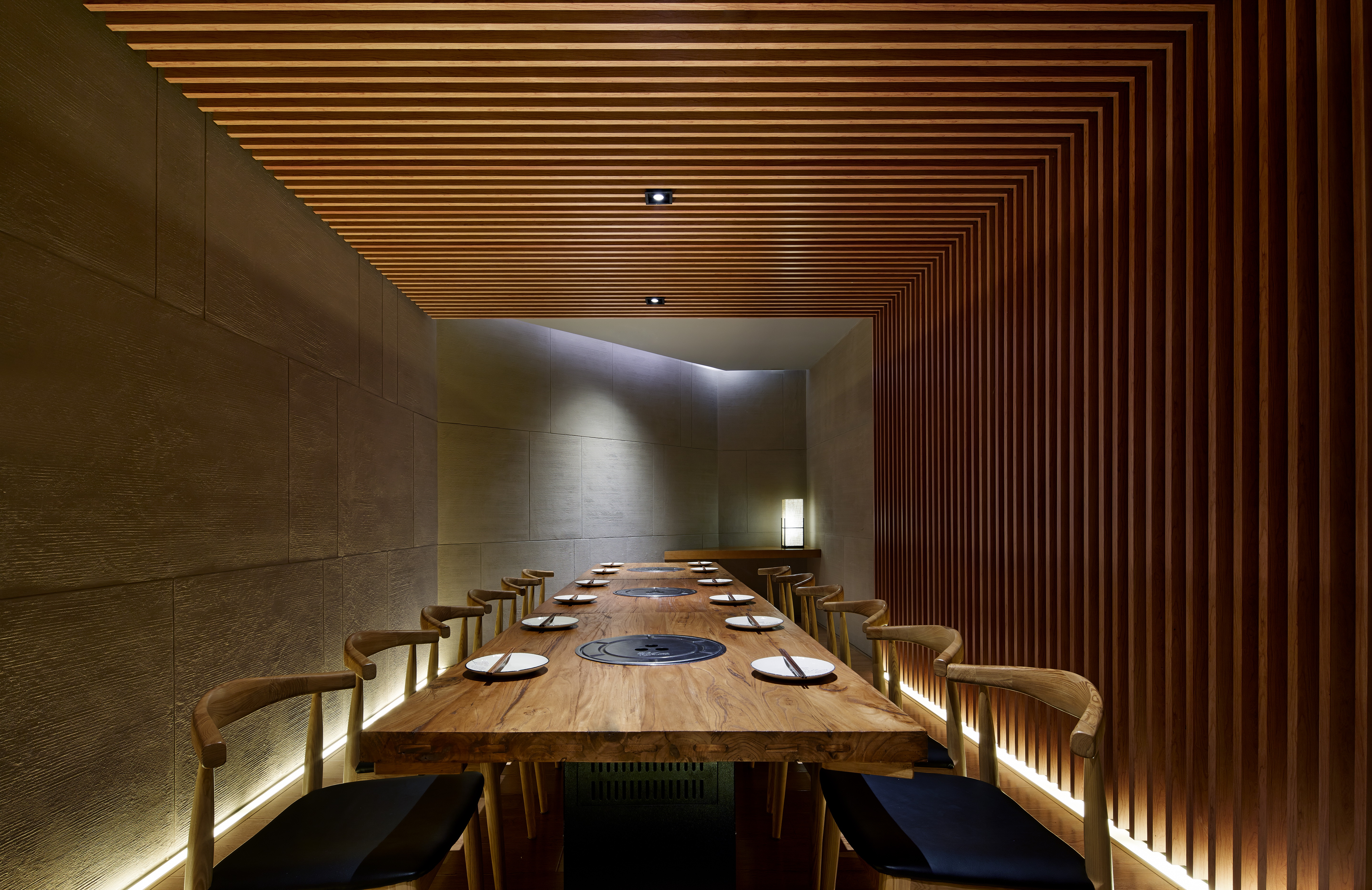

鹤一烤肉 Tsuruichi Yakiniku
Tsuruichi Yakiniku ,是一家高人氣的日本燒肉店,位於日本大阪東部的鶴橋地區,以其獨特的牛肉燒烤聞名當地。那裡是旅日韓國人與當地日本人的混居地,因此也形成了獨特的多元文化。“鶴一”用日語解讀的話,即為“鶴橋第一”的意思,更是近百年前鶴橋地區的第一間燒肉店。
本項目條形隔扇的使用說明,在日本建築語彙中條形隔扇一直是我們所常見到的,大量密實的直線條一定程度的體現日本審美的方式,我們在收集設計素材時發現了日本浮世繪上對與雨的有趣表現方式,「江戶名勝百景」是歌川廣重的最後一組版畫作,其中最著名的一幅即是「大橋驟雨」。更因曾被後期印象派大師梵谷所臨摹而令世界矚目。圖中捕捉大自然的瞬間變化及旅人的突然反應,密密麻麻一條條的線條表現夏天的傾盆大雨,這種藝術表現方式在西洋及中國水墨畫是看不到的。
設計理念抽象的還原了日本大阪鶴橋地區的擁擠的街道建築形象, 餐廳的兩個入口安排在”山牆” (中國建築語彙)上, 進入餐廳三角型的坡頂映入眼簾, 我們刻意壓低房檐, 意圖用強烈的三角形房頂來表達日式建築與山林的關係。在日本建築中, 如果入口開山牆上, 就叫做”妻入式”; 相反的, 如果是從平順的房檐下進入室內, 這種方式就叫”平入式”。 房檐的高度是2.1米, 即使作為住宅, 這個高度也很低。作為餐飲公共空間, 讓客人穿過這麼低矮的房檐進出包房, 設計這個高度被甲方投訴我們毫無常識可言, 這個高度伸手都能觸到房頂了。 房檐設計這麼矮, 意在弱化牆面, 強調錯落的三角形房頂, 牆壁消失於房檐的陰影下, 凸顯了在都市建築叢林中的小小山林。
本項目條形隔扇的使用說明,在日本建築語彙中條形隔扇一直是我們所常見到的,大量密實的直線條一定程度的體現日本審美的方式,我們在收集設計素材時發現了日本浮世繪上對與雨的有趣表現方式,「江戶名勝百景」是歌川廣重的最後一組版畫作,其中最著名的一幅即是「大橋驟雨」。更因曾被後期印象派大師梵谷所臨摹而令世界矚目。圖中捕捉大自然的瞬間變化及旅人的突然反應,密密麻麻一條條的線條表現夏天的傾盆大雨,這種藝術表現方式在西洋及中國水墨畫是看不到的。
設計理念抽象的還原了日本大阪鶴橋地區的擁擠的街道建築形象, 餐廳的兩個入口安排在”山牆” (中國建築語彙)上, 進入餐廳三角型的坡頂映入眼簾, 我們刻意壓低房檐, 意圖用強烈的三角形房頂來表達日式建築與山林的關係。在日本建築中, 如果入口開山牆上, 就叫做”妻入式”; 相反的, 如果是從平順的房檐下進入室內, 這種方式就叫”平入式”。 房檐的高度是2.1米, 即使作為住宅, 這個高度也很低。作為餐飲公共空間, 讓客人穿過這麼低矮的房檐進出包房, 設計這個高度被甲方投訴我們毫無常識可言, 這個高度伸手都能觸到房頂了。 房檐設計這麼矮, 意在弱化牆面, 強調錯落的三角形房頂, 牆壁消失於房檐的陰影下, 凸顯了在都市建築叢林中的小小山林。
Tsuruichi Yakiniku is a very popular Japanese Yakinikum restaurant famous for its wonderful beef barbecue. It is located in Tsuruichi area, east of Osaka, where many Korean families live among the local Japanese households, and therefore, it sees a unique and diverse culture there. Tsuruichi, in Japanese, means “the top one in Tsuruichi area”, and actually, it is the first Yakinikum restaurant in this area in the recent hundred years.
We used strip-type partition board in this project, because it is always used in Japanese architecture. And in fact, the use of numerous close-grained stripes, to some extent, satisfied the aesthetics of the Japanese people, because we found an interesting way of drawing rains in Ukiyo-e (a famous Japanese painting collection) when we were finding materials and inspiration for the design: the drawer Utagawa Hiroshige used dense strips to paint the pouring rains in Summer in the picture named Sudden Rain Falling on the Bridge of his Hundred Beautiful Sceneries in Edo Era collection. The sudden change of weather and the instant reactions of pedestrians were captured by the drawer and showed in the pictures, making a great painting collection and even attracting Vincent van Gogh’s attention and therefore, the picture collection became well-known in the world. This way of painting rain is unique also because you can neither see it in the Western paintings nor in Chinese ink paintings.
In the design, the restaurant echoes the crowded streets and dense buildings: the two entrances are at the gable walls, and when you are inside the restaurant, the tri-angle slope crest immediately comes to your sight. Also, we intentionally lower the eaves in order to use the tri-angle roof to indicate the relationship between Japanese architecture and the hill of woods. In Japanese architecture circle, if the entrance is in the gable wall, it is called “tsuma iri”, otherwise, if the entrance is under the eave, it’s called “hira iri”. The eave of this restaurant is only 2.1 meters, which is very low even for a residential building, let alone this is a restaurant, a public building. So we were claimed by the Developer that we have no common sense of architecture, and the customers are able to touch the roof as long as they stretch their arms. But we explained to them that we made the eave so low is because we want to make the walls hided by the eaves and their shades, in this way, the tri-angle roof can be stood out and therefore make the restaurant look like a small hill among the modern buildings in the city.









